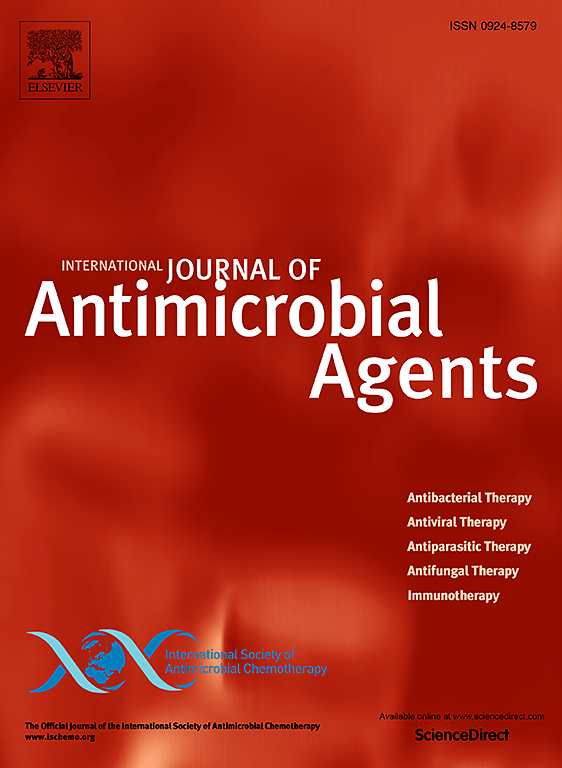Temporal, regional, and demographic differences among antimicrobial-resistant domestic Campylobacter jejuni human infections across the United States, 2013–2019
IF 4.9
2区 医学
Q1 INFECTIOUS DISEASES
International Journal of Antimicrobial Agents
Pub Date : 2025-02-20
DOI:10.1016/j.ijantimicag.2025.107467
引用次数: 0
Abstract
Human infections with antimicrobial-resistant Campylobacter jejuni increase morbidity, mortality, hospitalization, and treatment costs. Resistance to antimicrobials recommended to treat campylobacteriosis has increased in the United States, despite the mitigating efforts of public health authorities. This study analyzed publicly available antimicrobial resistance (AMR) monitoring data collected by the National Antimicrobial Resistance Monitoring System (NARMS) to assess temporal, regional, and demographic differences in AMR among domestically acquired C. jejuni infections across the United States between 2013 and 2019. Mann–Kendall tests evaluated trends in AMR throughout the study period. Poisson regression models assessed differences in resistance to each antimicrobial class among the years, age groups, and regions. Among the 7624 C. jejuni isolates, high resistance was identified against tetracyclines (n = 3504; 45.96%; 95% CI = 44.84–47.09), and quinolones (n = 2093; 27.45%; 95% CI = 26.45–28.47). An increasing trend in resistance to quinolones (P = 0.07) and a decreasing trend for tetracyclines (P = 0.036) were identified. The rate of isolates that showed resistance to all antimicrobial classes except tetracyclines was significantly higher in the state of Connecticut. Resistance rates for all antimicrobials except aminoglycosides were higher among the 20–39 year age group. Regions and age groups with the greatest AMR rates were identified, which warrants further studies to identify individual and area-level risk factors. To mitigate the burden of antimicrobial-resistant C. jejuni infections, health authorities should focus on regions and age groups with the highest risk.
2013-2019年美国国内耐药空肠弯曲杆菌人类感染的时间、地区和人口统计学差异
人类感染耐药空肠弯曲杆菌会增加发病率、死亡率、住院率和治疗费用。尽管公共卫生当局作出了缓解努力,但在美利坚合众国,对推荐用于治疗弯曲杆菌病的抗微生物药物的耐药性有所增加。本研究分析了国家抗菌素耐药性监测系统(NARMS)收集的公开可用的抗菌素耐药性(AMR)监测数据,以评估2013年至2019年美国国内获得性空肠梭菌感染AMR的时间、区域和人口差异。Mann-Kendall试验评估了整个研究期间抗菌素耐药性的趋势。泊松回归模型评估了不同年龄、年龄组和地区对每种抗菌素耐药性的差异。在7624株空肠梭菌中,鉴定出对四环素类药物的高耐药性(n= 3504;45.96%;95% CI=44.84-47.09),喹诺酮类药物(n= 2093;27.45%;95% CI = 26.45 - -28.47)。喹诺酮类药物耐药性呈上升趋势(p=0.07),四环素类药物耐药性呈下降趋势(p = 0.036)。除四环素类外,对所有抗菌素类均耐药的分离株在康涅狄格州明显较高。除氨基糖苷类外,所有抗菌素的耐药率在20至39岁年龄组中较高。确定了AMR率最高的地区和年龄组,这值得进一步研究以确定个人和地区层面的风险因素。为减轻耐药空肠梭菌感染的负担,卫生当局应重点关注风险最高的地区和年龄组。
本文章由计算机程序翻译,如有差异,请以英文原文为准。
求助全文
约1分钟内获得全文
求助全文
来源期刊
CiteScore
21.60
自引率
0.90%
发文量
176
审稿时长
36 days
期刊介绍:
The International Journal of Antimicrobial Agents is a peer-reviewed publication offering comprehensive and current reference information on the physical, pharmacological, in vitro, and clinical properties of individual antimicrobial agents, covering antiviral, antiparasitic, antibacterial, and antifungal agents. The journal not only communicates new trends and developments through authoritative review articles but also addresses the critical issue of antimicrobial resistance, both in hospital and community settings. Published content includes solicited reviews by leading experts and high-quality original research papers in the specified fields.

 求助内容:
求助内容: 应助结果提醒方式:
应助结果提醒方式:


